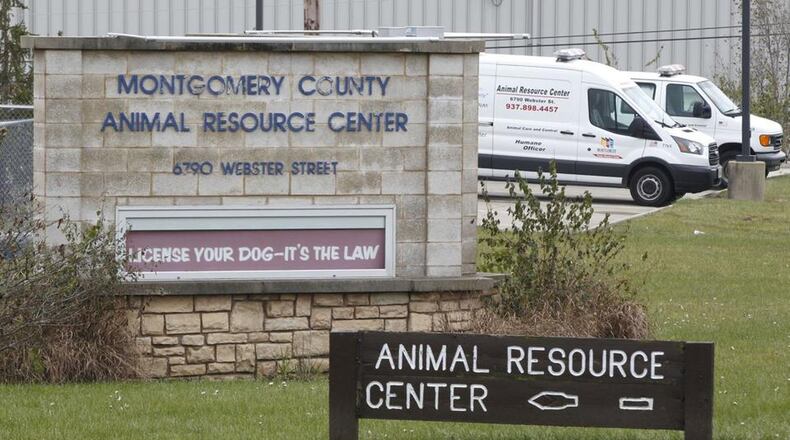“Facing the overwhelming number of animals flowing into the shelter daily, in the absence of proactive live outcome programs, is extremely stressful for ARC staff and volunteers and leads to inadequate animal care,” the report reads. “As staff are stretched too thin, best practices are forsaken in the interest of speed to finish a task. But information captured at the point of intake is crucial for the most efficient pathway planning.”
RELATED: County commissioners officially fire animal shelter director
The assessment, conducted between from Nov. 26-30, was a tipping point in terminating former ARC Director Mark Kumpf, said Montgomery County Administrator Michael Colbert.
“During this review, it became clear that the Animal Resource Center needed new leadership and direction,” Colbert said. “The county commissioners took immediate action and appointed Bob Gruhl as interim director of the Animal Resource Center to improve overall shelter operations and ensure that the best practices recommended in this report are fully implemented.”
Up to six more staff members are needed to care for animals at the facility as well as two additional part-time vets to handle shelter medicine and surgery, according to the report. The shortage is so acute the consultants suggest the county try to get temporary staffing from the Humane Society of Greater Dayton or SICSA.
Consultants also raise alarm that shelter employees have not been forthright in communicating with the public, including animal welfare advocates who said that the ARC puts too many animals to death — in some cases while their owners are still looking for them.
ARC’s “website states and staff reports that euthanasia is not done for space, which is not an accurate statement,” the report reads. Also in the report: “All information captured about an animal must be true, correct and up to date in real time to prevent any fatal or legal errors. Animals are euthanized for space and many for illness and behavior issues as a result of their shelter stay. Saying otherwise has created an understandable culture of mistrust with the community that will take time and life-saving proof to rectify.”
More than 3,000 dogs and cats were euthanized last year, according to the county.
Colbert said the report was upsetting.
“The commissioners and I were troubled and dismayed by the overall findings of this report,” Colbert said. “We care deeply about the well-being of people and pets in our community. We have made improving the Animal Resource Center and increasing our live release rate a top priority.”
Consultants zeroed in on dozens of issues that require “immediate attention” and provided 30 “emergency action items.”
The report indicates employees improperly store vaccines, reuse syringes and likely run afoul of the state law and the federal Drug Enforcement Agency by not keeping track of a euthanasia solution called Fatal Plus.
“Many of the recommendations require a new perspective and corporate culture shift regarding how the shelter assists constituents,” the report reads.
Team Shelter USA’s report also asks the county to consider dissolving the current advisory board and replace with an ARC Task Force.
Due to the report, the county plans a number of steps to increase the live release rate. Animal rights advocates say a live release rate of 90 percent or higher is more in line with modern shelter standards. But the rate last year at the ARC was much lower: 56.7 percent.
Some of the steps include:
- Discontinuing routine temperament testing
- Adding new protocols that ensure the adoption area is full at all times
- Implementing fee-waived adoptions until further notice
- Eliminating physical exams and fecal tests by vet staff unless there is a clear medical need
- Fast tracking hiring for open positions to ensure appropriate staffing levels to implement best practices
- Creating of new outreach coordinator to focus on working with rescue organizations and on adoption
- Change in cat control contracts with jurisdictions to transition to Return to Field (trap/spay/neuter/release) programs in the jurisdictions
Paul Leonard is a former Dayton mayor and is also an attorney representing a Kettering couple whose dog was euthanized at the facility and is now suing the county.
“From my point of view, it is not a shelter, it’s a death row,” Leonard previously said.
MORE: Critics target Montgomery Co. Animal Resource Center for animal deaths
Kumpf is a named defendant in a wrongful death lawsuit of Klonda Richey, who was mauled by a dog in Dayton after she alerted the ARC about two dozen times to a problem dog next door. Court documents filed by Richey’s estate allege key evidence in the case was destroyed by the ARC.
Team Shelter USA was created by Dr. Sara Pizano. The group assessing the facility also included Dr. Becca Boronat of the Charleston (S.C.) Animal Society, Cameron Moore from the University of Florida, and Dr. Kim Sanders of Anderson County (S.C.) PAWS.
The shelter handles about 10,000 animals each year, and animal care and control officers respond to more than 15,000 requests for service annually that usually involve rescuing a lost, stray, sick or injured dog, according to the county. Additionally, the agency investigates about 1,200 complaints of canine cruelty or neglect each year.
About the Author

